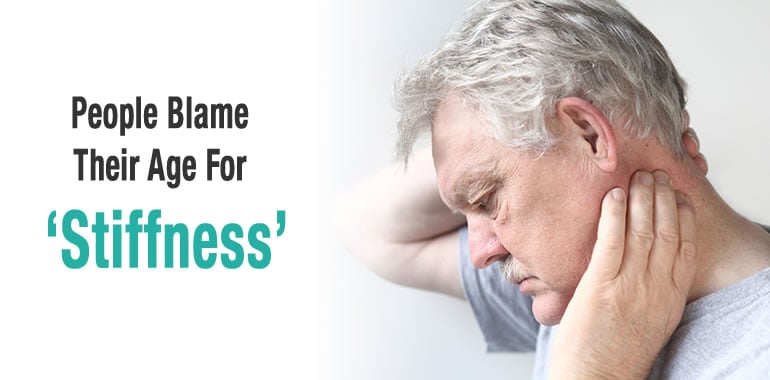
Generally, people blame their age for stiffness; they consider stiffness as something that we all live with it. It is a convenient scapegoat: people didn’t have this stiffness when they were younger. But, is it all about age? Think about this for a moment: people are not getting old and stiff, but stiff and old.
Let’s take a moment to consider this. Stiffness comes in stages. It usually begins with pain and loss of motion, thereafter leading to decreased mobility, speed, balance, and a loss of independence. In other words, it generally takes time. Yet, stiffness can happen at a young age, too. A good example of this is the discomfort felt after spraining an ankle. In this case, inflammation is the main reason for this kind of injury-related stiffness. By contrast, the cause of stiffness in adults is often a combination of inflammation and dehydration in the joints… over time.
Staying limber makes people looks younger – that’s a fact. Staying limber is also the best way to combat stiffness. It isn’t your age… it’s what you do with it! In fact, staying limber is absolutely vital in nourishing the joint and minimizing inflammation, thus leading to health.
So, forget age. The longer you wait… the older you feel. Turn, instead, to the real causes of the issue. Dehydration in the joint is a massive problem. Just in the way that skin gets wrinkles, joints can lose their water content and become stiff. And even though this is a natural aging process, you can slow the process down by following these steps.
First, do moderate intensity exercises regularly. This will lubricate your joints. Think about the automobile, for example. If a car stops driving for a few weeks, and all the components of the car begin to freeze up because the fluids get thick and block hoses, then the engine will eventually be incapable of starting. It’s the same with the human body: our joints are designed to move just like an automobile’s components. When a car is operated, the heat expands into all the compartments, thereby lubricating the entire engine car. When you exercise, you’re lubricating your joints. Physical activity is absolutely essential; a sedentary lifestyle is the number one reason for stiffness. There are four different exercises that will be particularly beneficial to you: stretching, aerobic activities (e.g., walking, biking, swimming), resistance training (e.g., weightlifting), and balance exercises. For more information about these exercises, please see my other articles.
Secondly, drink more water. Drinking 8 cups a day is recommended; it will slow down the dehydration process. Drink water about 30 min before you exercise, during the actual exercise, and even after a workout. Water is one of the best medicines you can drink and it is one of the best cosmetics you can wear! You’ll look and feel younger in no time.
Now that you know how to lubricate the joint, it’s also important to understand how to minimize inflammation:
Inflammation is the body’s defense mechanism when fighting against foreign objects such as viruses, bacteria, etc. In the case of the joint, inflammation happens when your immune cells respond to your own body as a foreign object. It’s likely to happen when your joint has micro injuries or stress, both which lead to damage on the joint surface. In the worst case scenario, this can create a loose body part inside of your joint, such as chipped cartilage, ligament, etc. Here, our immune system creates enzymes to fight against these stray pieces, and these enzymes often end up attacking our own cartilage.
In order to prevent the above situation, it’s vital to have an expert look at your posture and movement. Why? Well, alignment issues such as bowed knees, foot arch drops, toe out situations, etc., can cause issues down the line. These postural problems, which are often birthed from a bad habit, can put extra stress on your joints, muscles, and surrounding tissue area. As a result, the extra stress can damage the joint and can trigger the inflammation process. Luckily, with the help of an expert, those problems can be addressed by changing habits, correcting posture with manual therapy and exercises, wearing orthotics or braces, etc.
Incorrect movement also creates stress on your body, ultimately leading to micro-injuries that kick-start the inflammation in your joint. As I mentioned in a previous post, one good example of incorrect movement is found when the body guards or overcompensates. That is, when you have an injury in one part of your body, you start compensating on the other side, thus putting extra stress on certain parts of the body to protect others. Unfortunately, those changes can damage your joint. So, normalizing your walking and movement pattern is essential for recovery.
Furthermore, changing your diet would be helpful in minimizing inflammation. Research shows that losing 10% of your body weight offers significant benefits to the joint. And what’s more, the healthier your immune system is – as a result of an improved diet – the looser your joint is. Remember, lubrication is key! Avoiding sugar and consuming fewer animal-based foods can be very beneficial. Moreover, adding natural antioxidants and anti-inflammatories, both of which are found in colorful fruits and vegetables, will boost your immune system. For more information about the benefits of anti-inflammatory foods, please see my previous article.
If you’re the supplement type, there are dietary supplements that also help with joint inflammation. Try turmeric, collagen type II, hyaluronic acid, and Boswellia for their added benefits.
Last, but by no means least, you should be investing in the wellness of your brain. Gene researchers point out the importance of being happy and grateful when it comes to overcoming physical ailments. Being content actually activates genes that help the immune system. Within 20 minutes of having a good time, such as working out, doing volunteer work, or spending quality time with your friends and families at home, church, and in the community, your immune system will have been boosted tremendously!
The underlying truth is that we need to be proactive in order to fight against joint stiffness and pain. There are no magic pills or surgeries to cure this problem. The good news is, though, that we have enough sound research to point us in the right direction. And remember, God wants you to live your life fully: it is entirely possible when you make the right choices. Experience your life FULLY, right now!
- Stop treating people like dead - March 25, 2024
- Stop Asking Me ‘Where are you from?” - March 25, 2024
- You Need the Right Diagnosis, not the Right Technique - November 25, 2020



